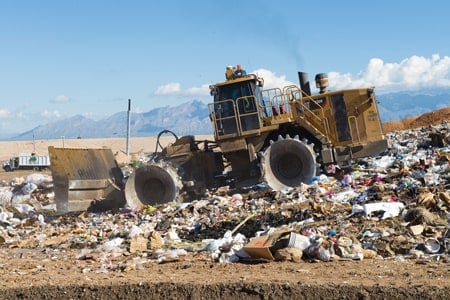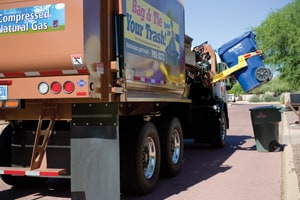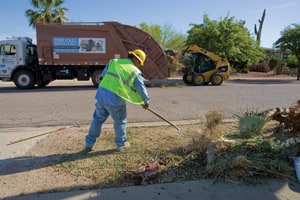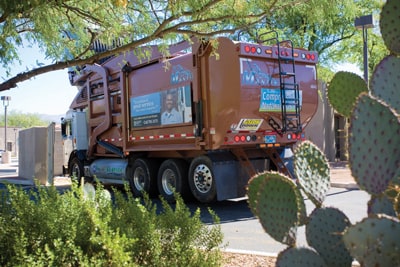Priding themselves on not only providing refuse and recycling operations, but also focusing on how they can provide a cleaner community, Tucson’s Department of Environmental and General Services has made operational improvements every year and followed strategies to stay ahead of a changing industry.
As the second largest city in the state and home to the University of Arizona, Tucson is a unique city in its diversity and location—surrounded by five ranges of mountains: the Santa Catalina Mountains and the Tortolita Mountains to the north, the Santa Rita Mountains to the south, the Rincon Mountains to the east and the Tucson Mountains to the west. Tucson’s Department of Environmental and General Services has been in existence since the city was incorporated in 1887. In 2004 it went through a major transition becoming an enterprise fund, which means that it is self-supporting and now operated outside of the general fund. In 2016, the Department of Environmental Services (refuse, recycling, landfill operations and HHW) was merged with General Services becoming what it is now—the Environmental and General Services Department. Taking place from a budgetary perspective, the two departments were co-located in the same building with two separate administrative offices and staff and transitioned into one department. Another benefit was that there was a disconnect between recycling and refuse operations and fleet support, so this combination allowed the department to really further integrate operations—very similar in nature to what the private haulers have. The following was combined: finance, HR, procurement maintenance, policy standards, etc. “As we move forward with a combination of the department, we are priding ourselves on not only providing refuse and recycling operations, but we are also focusing on how we can provide a cleaner community and provide support services to various neighborhood associations to clean up our community more than we have done in the past, and this transition has helped us do that,” says Director Carlos De La Torre.

Providing refuse and recycling (including brush and bulky) services to 142,000 residential customers and 3,000 commercial customers, the Environmental and General Services Department employs a staff of more than 430 employees; they pick up roughly 220,000 tons per year of refuse and 38,000 tons of mixed, single-stream recyclables, including cardboard, plastics, aluminum, tin, etc.—a total of 26 items on the recycle list. The Department has a contract with Republic and takes the recyclables to their facilities.
In addition, the Department also operates an active landfill for the Tucson area. It spans 1,087 acres with the 50-acre active cell on top. The landfill receives about 720,000 tons of material each year, 2,500 tons per day. They just started construction on an additional cell that should give the landfill another seven years of useful life. The Department has done very well in acquiring land around the landfill because, as De La Torre points out, if they are going to be operating the landfill for the next 70 years, they can be a good neighbor by controlling the properties outside of the active landfill area.
Strategic Transitions
When China’s National Sword ruling began, it affected the Department quite a bit, but they were determined to be proactive in how they dealt with the situation. “Our combined processing fees went from $38 per ton to $100 per ton, and the change is hitting us at $4 million in additional costs for recycling and another $1 million in lost revenue because of the drop in commodities value,” said De La Torre. “That equates to our customers getting about a $3 increase in their monthly bills. We spoke to our city council to see how they wanted us to move forward regarding rates or adjusting services, but we did not receive approval to put the rate increases into place. They did, however, give the approval to adjust services. So, we are transitioning our curbside recycling service from every week pickup to every other week. We saw that the recycling bins were not completely full every single week, so we did a pilot program in one area and discovered that most of the recycling bins were half or a third full, so even if we reduced the level of service to every other week, we are still capturing the volume and the same space as before. We are projected to save $1.4 million this fiscal year.” The Department also went through some operational changes, such as the reduction of its capital program to compensate for the loss. They have also recommended the removal of glass and paper from the recyclable list, but approvals have not gone through yet.

De La Torre points out that recycling’s business model as we have known for the past three decades is no longer valid. The Department as a whole needs to look closely at its program and collapse it in its entirety and build it back up again. “We don’t foresee anything significantly changing in the next three to five years,” said De La Torre. “I think it is going to be almost status quo with China taking the lead and continuing to exercise the leadership authority with other countries following suit. If we have a stream of recyclables that goes to the far east, little by little we are going to start seeing a different issue or need for those products. I think the only way to solve this challenge is to keep things here domestically.” De La Torre goes on to say that while plastics are doing okay right now, they may not be in the near future. The Department is anticipating what the recycling market would look like and they are seeing a lot of movement on cutting back the use of plastics, including single use containers, water bottles and soda bottles. “We see the plastics manufacturers making an effort to cut back and companies trying to move from a plastic bottle to an aluminum can,” De La Torre said. “All the noise we are starting to hear about plastic in the ocean is going to lead to a good social media movement and some of that stuff may diminish. However, if it took us three decades for our current recycling program to become what it is today, it will most likely take as much time to reimagine and redo it again for the next three decades. We don’t think that the current model is going to work and that is why we really need to recreate a new program around those changes and realities.”

In addition to taking on recycling challenges, one of the key strategies from an efficiency and productivity perspective to stay ahead of the curve is that the department has transitioned its fleets from diesel to CNG, with virtually 85 percent of the fleet being converted. It cuts back on operating costs with regards to fuel, and it limits the amount of time the crews fuel up their trucks. Now, the vehicles get parked at night and filled so when operators come in the morning, they are ready to go on the route immediately. “In the past, all the trucks came in and left at the same time,” De La Torre said. “It really cut back on our efficiencies by a couple of hours just to fuel vehicles.”
Internal Operations
With a very extensive hiring process, potential employees first have to go through the application process, a background check, and a practical test. “Most of the folks that have a CDL license don’t have the experience of running a refuse truck,” De La Torre says. “We consider those that have driven a similar vehicle as we move through the selection process. It takes almost a full day. Candidates go through a refuse truck obstacle course and we look at ensuring that they know what they are doing in the pre- and post-check inspections, including being able to service a vehicle or refuse bin, etc.” Once a driver is on board, he or she must go through the city’s general safety procedures and go through 40 hours of training to get familiar with the equipment. After that takes place, the new hire is paired up with a seasoned operator who observes behavior and is with him or her for a period of four weeks, going through all the different scenarios. Once the training operator is comfortable after a four-week period, that operator can go out on his or her own collection routes. There is also follow up from the supervisor to make sure the routes are completed in a timely manner. In addition, with a GPS tracking system, the Department can not only see where the vehicle is, but they can also monitor where the employee has gone and make sure things are okay on the route.
Pat Tapia, Deputy Director, adds, “One thing the city requires is that new employees are on a one-year probation. We put our operators on the same routes for a whole year to measure their progress,and to see if there is anything we need to work with them on. Before, this transition, the new hires would bounce around on different routes and it was hard to evaluate their production—now we can give them a fair evaluation and see how they operate on an annual basis.”

Currently, the city is transitioning to consolidating and standardizing all of the Department’s safety programs, HR and other procedures in the next couple of years. “We do have one part time person who is the safety liaison for us. We are in the process of re-classifying the position so we can hire our own internal safety person,” says De La Torre. Safety meetings are held on a monthly basis and as the need arises, operators can address anyone on an individual basis. It is the same with landfill operations—every week there is a safety meeting to get everyone on the same page.
“We also work with SWANA (Solid Waste Association of North America,” says Tapia. “The Arizona SWANA Safety Ambassador comes in once a year and gives driver training, shows videos and talks about accidents, as well as driver coaching and distracted driving. Once that is finished, we start implementing the best practices.”
Not only is the Environmental and General Services Department active on social media across several platforms, but they also participate in spring and fall community events with a booth or table where they offer creative activities so people can learn more about their services. They are also part of home shows and provide a school program for middle school students, putting on about 400 presentations per year. Every Halloween and Valentine’s Day, the Department offers a landfill and MRF tour and partners up with other city departments quite often, especially those involved with the sustainability initiatives, like transportation or Tucson Water. They also work with Tucson Clean & Beautiful on several outreach programs including classes for master recyclers.
Retaining Employees
One of the challenges that the Department is going to be facing within the next year is the fact that while they have standardized their fleet, the body manufacturer has been absorbed by another company. They will not have the level of customer service they need and cannot continue with the same company, so they will need to re-evaluate how the fleet is replaced as they move down the road.
Another challenge, pointed out by Tapia is getting the industry off of the top five most dangerous jobs. “That is a huge challenge and it is something that we have not been able to improve for a long time,” said Tapia. “How do we get it off of the top five list? This is something we need to address and have it come up more often for discussion.”
De La Torre points out that it is also challenging retaining quality operators in the industry. “Every time we do a recruitment effort, we get around 50 to 60 applicants and by the time we are done, we end up having a pool of 10 individuals that we bring aboard; however, the difficulty lies in retaining them,” says De La Torre. “It really takes a special skill to sit in a truck 10 hours a day emptying containers, operating a very sophisticated piece of equipment. Plus, you have to be very in-tune to what you are doing and this is challenging for many people. It is a very high-intensive production operation on a daily basis and this type of job takes a very special person to be able to do that.” A few years ago, the Department implemented retention pay, so if you are an operator and you have been at the job between two to five years, another $1 is added on to your rate of pay. For those who have been there more than five years, the salary is adjusted by $1.50 per hour. “That helped us a little bit for the first year, but now it is being eroded because of other employers in the area. They are hiring drivers at $20 per hour with a flexible schedule,compared to us with a very rigid schedule—starting early in the morning and working until the late afternoon on a trash route,” says De La Torre. “The city as a whole goes through many strategies to retain employees. There are some programs in place today that try to address that wage compression that has developed over the many years, but with little fiscal capacity that does create some issues.”
A Strong Culture of Service
Currently, as De La Torre pointed out earlier, one of the things the Department is looking at is collapsing its recycling program and building it back into a completely new program that is more focused on diverting and processing organics as well as educating the public on the rejection, reuse and reduction of the use of plastics. “We want to drive that message of reduction rather than just focusing on recycling,” said De La Torre. “We want to create a social media movement as to the impacts of the environment and really segue it around significantly reducing the use of single-use containers—what is happening today, how it will affect future generations and how we can begin to change that at a local level.”
“We are really proud of the way we have been able to hold our curbside refuse and recycling rate for the last 10 years, our operational improvements that we’ve made every year and our CNG transition,” points out Tapia. “We’ve also gone from a six-day work week to a five-day work week. This resulted in many changes, including cutting routes, standardizing equipment and reducing our residential fleet units from 72 to 60.”
“Our department has an excellent reputation for customer service,” says Cristina Polsgrove, Public Information Officer for the City of Tucson Environmental and General Services. “When people call with an issue, it gets resolved quickly. We are very responsive, and I think that over the last two years we have really created some initiatives to support the community more in terms of clean cities—expanding our brush and bulky program, working with the neighborhoods, etc. and we are reaping benefits from that.”
De La Torre agrees, “None of that would occur without the very strong culture of service, commitment, execution and the ‘Let’s get it done attitude’ that is very prevalent. We are so customer service-focused that our motto is ‘No trash left behind’ and it resonates throughout the Department and speaks well for the employees citywide.” | WA
For more information, contact Cristina Polsgrove at [email protected].
